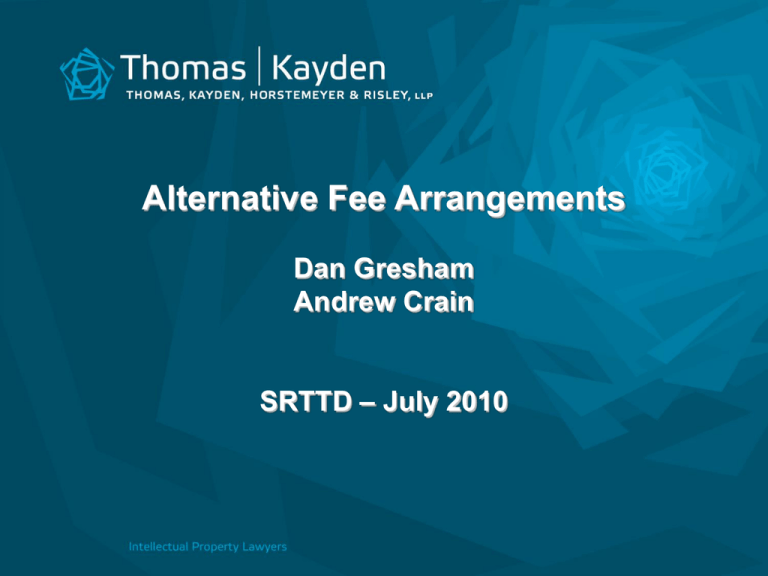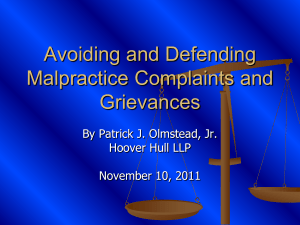Alternative Fee Arrangements
advertisement

Alternative Fee Arrangements Dan Gresham Andrew Crain SRTTD – July 2010 2 Traditional Fee Arrangement: Billable Hours Alternative Fee Arrangements: • • • • • Fixed or Flat Fees Retainer Agreements Phased Hourly Billing with Budgets; Capped Fees Discounted Hourly Rates; Volume Discounts Hybrid (Discounted Rates and/or Capped Fees with additional incentives based on outcome) • Contingent Fees 3 TRADITONAL FEE ARRANGEMENT -- Billable Hours Description: Attorneys keep track of time spent on particular matters and bill according to hourly rate for each attorney. Advantages: Certainty that time spent on matter is compensated at agreed-upon hourly rates, which are governed by market forces. “A lawyer's time and advice are his stock in trade” -- Abraham Lincoln Disadvantages: For clients, uncertainty as to budgeting; unfortunately, some attorneys and firms have developed reputations for overstaffing cases because they are billing by the hour. 4 ALTERNATIVE FEE ARRANGEMENT -- Fixed or Flat Fees Description: Client engages attorney to perform specific service for a fixed amount agreed to in advance. Advantages: No uncertainty as to amount of fee. Works best in context of legal services involving tasks that attorneys perform repetitively so that there is a reasonable expectation on both sides that the fixed fee represents (1) a fair value for the service, and (2) that the time it takes to perform the service can be estimated in advance with reasonable accuracy based on past experience (e.g., wills, confidentiality agreements, patent applications for similar technologies). Disadvantages: Law firm assumes the risk of cost overruns. Does not work particularly well in litigation due to adversarial nature of process, which makes it difficult to estimate accurately the time it may take to perform a service. 5 ALTERNATIVE FEE ARRANGEMENT -- Retainer Agreements - In the context of litigation, the term “Retainer Agreement” is often used in the context of a standard hourly fee arrangement to refer to a prepayment by the client that is credited against actual billings as the case proceeds. - In the context of Alternative Fee Arrangements, a “Retainer Agreement” is simply an agreement between a client and attorney on a set amount that the client will pay to ensure the attorney’s availability to represent client during a specific period of time. For example, a client may agree to pay an attorney $5,000.00 per month for one year to handle all matters that arise for the client during that time period. Advantages: Budget certainty for the client, cash flow certainty for the attorney. Disadvantages: Difficulty in estimating accurately how much (or little) legal work may be required during a specific time period. As with flat fee arrangements, does not tend to work well for litigation due to adversarial nature of process. 6 ALTERNATIVE FEE ARRANGEMENT – Phased Hourly Billing with Budgets; Capped Fees Description: Client and attorney agree for set amount to be budgeted for each stage of a matter. The parties may further agree that the budget amount will constitute a “cap” (i.e., a “not to exceed” number) for that stage. Advantages: Up-front certainty for client. Can be adjusted for each phase of a matter. Disadvantages: Adversarial nature of litigation makes it extremely difficult to estimate accurately how much (or little) legal work may be required during each specific phase of a litigation matter. Client may be overpaying or underpaying for actual work done. Attorney’s focus on staying within budget might be detrimental to necessary case preparation. 7 ALTERNATIVE FEE ARRANGEMENT – Discounted Hourly Rates; Volume Discounts Description: Attorney agrees to give client a discount on hourly rates based on expectation or guarantee of repeat business or a certain volume of work. Advantages: Client gets a discounted hourly rate. Attorney gets a reasonable expectation of repeat business. Works well for high volume, fairly predictable matters. Disadvantages: For litigation, this involves straight hourly billing (albeit at discounted rates); attorneys may be encouraged to incur more billable hours to offset discounted rates. Intellectual property litigation is typically lengthy, complicated, and time consuming. Client may not be inclined to engage in multiple repetitive lawsuits. 8 ALTERNATIVE FEE ARRANGEMENT – Hybrid (Discounted Rates and/or Capped Fees with additional incentives based on outcome) Description: Incentives based on outcome can be used to address concerns about discounted rates or capped fees. Advantages: Due to the uncertainty inherent in intellectual property litigation, use of incentives based on outcome may be appropriate. If client achieves a substantial recovery, the additional incentives could be paid out of the recovery. If the client does not achieve a substantial recovery, the costs are capped. Potential additional compensation based on outcome would be additional motivator for attorney. Disadvantages: Although the additional incentives mitigate the disadvantages somewhat, the hybrid approach involves the same types of disadvantages as the underlying arrangements without the additional incentives. 9 ALTERNATIVE FEE ARRANGEMENT – Contingent Fees Description: Attorney’s compensation is contingent on results achieved. Attorney is typically paid a predetermined percentage of the client’s recovery. If client doesn’t win, the attorney does not get paid. Percentage may escalate from initial lower rate to a higher rate as case progresses toward trial and key events occur. Advantages: Limits economic impact of litigation on client. Typically, clients are only responsible for out-of-pocket expenses (e.g., travel costs, costs of depositions, court costs). Disadvantages: Attorney assumes almost all the risk. Attorney may be reluctant to take marginal case, or even potentially strong case against adversary with litigious reputation. Stigma attached to contingent fee attorneys in popular culture. - To mitigate disadvantage to attorney, client may sometimes agree to pay for law firm’s initial investigation on hourly and/or flat fee basis (typically with a cap). Attorney’s percentage of recovery may be negotiated depending on perceived strength of case and assessment of potential recovery.











